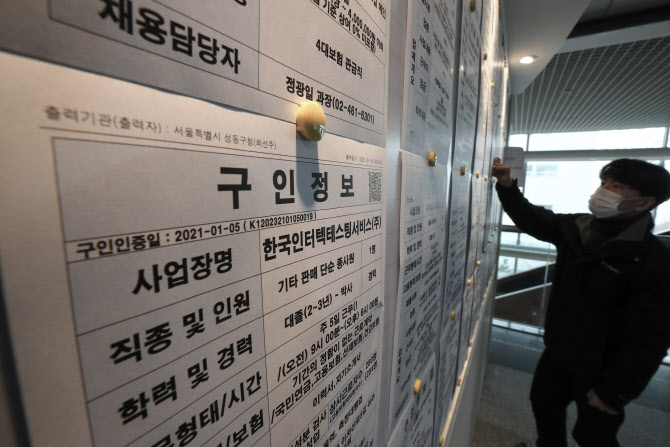About 830,000 temporary leave’the largest ever 34.6% in their 20s and 30s
Corona aftermath, business sluggishness, business interruption 11.7 → 44.4% in a year
Government launches youth job experience, but homework such as strengthening diversity
2 Lee Mi-sook (36, pseudonym), a lecturer at academy, is suffering from life difficulties due to repeated banning of gatherings at the academy due to Corona 19. In the country, he received more than 1 million won as a special type of worker (special high school), but it was not enough to pay monthly rent. It is difficult to find a job at a company other than Ieje, and it is difficult to find a part-time job at a convenience store. Recently, the academy has opened its doors and has been working again, but I am uneasy about when it will be banned again.
The employment crisis caused by Corona 19 was more painful for ‘2030 generations’, a relatively vulnerable class. The narrower job openings compared to the previous year are often pushed out of the job they were in. In the aftermath of social distancing, the face-to-face service industry, which has a high proportion of young people, was the most shocked. It is pointed out that the government has tried to reduce the impact by supporting young people’s job experience, but the policy is not effective, such as not achieving even business goals.
|
Service industry direct hit… 2030 damage was greater
According to the National Statistical Office on the 24th, the number of employed people last year decreased by 218,000 compared to the previous year, showing the largest decline since 1998 (-1276,000 people) during the financial crisis.
The number of ‘resting’ people who say they are just taking a break without studying or doing housework is 2,374,000, and the number of temporary leavers is 837,000, the most since the statistics were written. The job market is suffering from a decrease in the number of employed as well as an increase in the potential unemployed.
Especially, those in their twenties and thirties who are in the midst of learning to work as a freshman in society were hit directly by the shock of employment. The number of employed people in their 20s and 30s declined by 311,000 during the same period, which is a larger decline than those in their 40s and 50s (-246,000), which is the’waist of employment’.
As a result of analyzing the employment trend and microdata of the National Statistical Office, the proportion of people in their 20s and 30s who took a break recorded 28.2% and 34.6% of temporary leave.
The number of people in their twenties taking a break was 415,000, an increase of 25.0% from the previous year, and temporary leave (86,000 people) surged 139.8% during the same period. This is the highest increase in all age groups. Even in their 30s, 254,000 people took a break and 204,000 people took temporary leave, up 19.2% and 33.3%, respectively.
What stands out is that during the temporary leave last year, the number of reasons that are not voluntary factors such as vacation has increased significantly.
The reasons for temporary leave are divided into △ temporary sickness and accidents △ annual leave and vacation △ education and training △ childcare △ family reasons △ labor disputes △ business sluggishness and suspension of work.
As a result of the microdata analysis of employment trends, 371,000 (44.4%) people accounted for the largest share of temporary leave last year due to sluggish business or interruption. In 2019 alone, out of all temporary leave (407,000 people), only 11.7% (48,000 people) had business sluggishness and shutdown, but jumped more than 30 percentage points in a year. In terms of numbers, it increased 7.9 times.
On the other hand, annual leave and leave (40.8%), which accounted for the largest share of temporary leave in 2019, fell by more than 8 percentage points to 32.2% last year. In fact, nearly half of the’unintentional leave’ took up.
Looking at the increase and decrease in the number of employed by industry, the wholesale and retail businesses, mainly in the face-to-face service industry, and the accommodation and restaurant businesses, which were hit hard by Corona 19, fell 160,000 (4.4%) and 159,000 (6.9%), respectively. These industries have a high proportion of young people in their 20s and 30s, which is interpreted as having an impact on employment.
|
Companies turned away from new hiring due to corona uncertainty
In the case of the’expanded unemployment rate (employment subsidiary index 3)’, which is also called the actual perceived indicator including the potential economically active population, youth aged 15 to 29 exceeded 25% for the first time in history last year (25.1%). It means that the unemployed young people are the highest in history when they are not looking for a job, but even those who wish to find a job.
The road to new hiring this year is also grim. According to the Ministry of Employment and Labor’s’Launch Force Survey for Businesses by Job Type for the Second Half of 2020′, the number of businesses with five or more commercially employed from October last year to March this year decreased 1.1% from the same period last year to 253,000, the lowest level since the 2008 survey Recorded.
The government also recognized the seriousness of the youth employment crisis and announced additional measures in the first quarter, pointing out that an effective plan is urgent.
Seong Jae-min, a research fellow at the Korea Labor Institute, said, “Other age groups with employment experience have opportunities such as turnover, but young people face greater employment difficulties because new hiring itself is blocked.” As much as possible, additional responses are needed.”
|
ⒸComprehensive Economic Information Media E-Daily-Unauthorized commercial reproduction & redistribution prohibited



